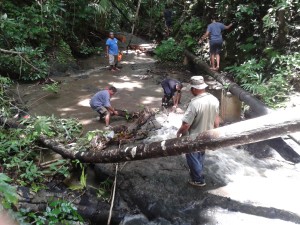Most of the 20,000 citizens of Palau live on the island of Koror, while the main watershed and reservoir for the country lie on the adjacent island of Babeldaob. The primary water main connecting the two islands ruptured in 2014, leaving the 14,000 residents of Koror with extremely limited access to water from their public water supply. On the outer islands of Palau, as in the other entities, rainwater and shallow wells are primary sources of drinking water.
As part of a national effort to preserve watersheds and prepare for the 2016 El Niño drought, Water for Life helped communities collaborate with ecologists to protect and revitalize streams and other rain basin catchments that were traditionally used as drinking water sources but have been neglected in recent decades. Teams planted vegetation, repaired dykes and dams, cleared trash from streambeds, etc.
The WfL Core Team organized to protect the Meyuns water source by covering it to limit contamination from surrounding tress.
Other activities include working with teachers to create engaging, out-of-classroom and informal science-learning experiences to help youth gain an appreciation of their unique island resources.
For the out-of-classroom and informal learning guides, see:
What is Palau Made Of? in high resolution – or see a low resolution version – angaur-module1-lowres
Where Does Our Water Come From? In high resolution, angaur-module2-highres or in low resolution angaur-module2-lowres

